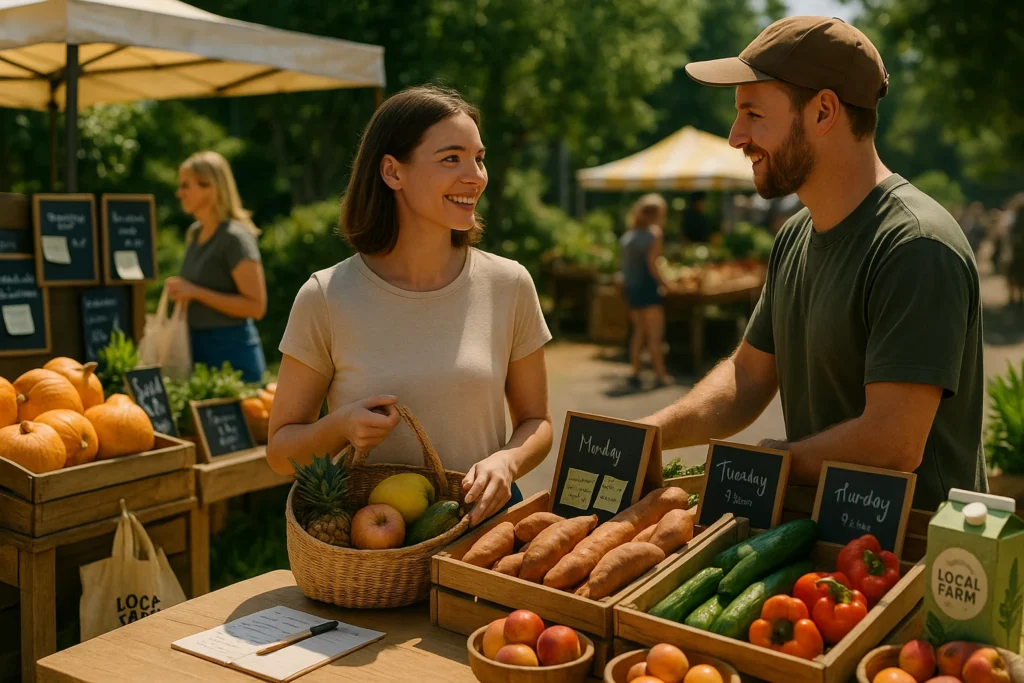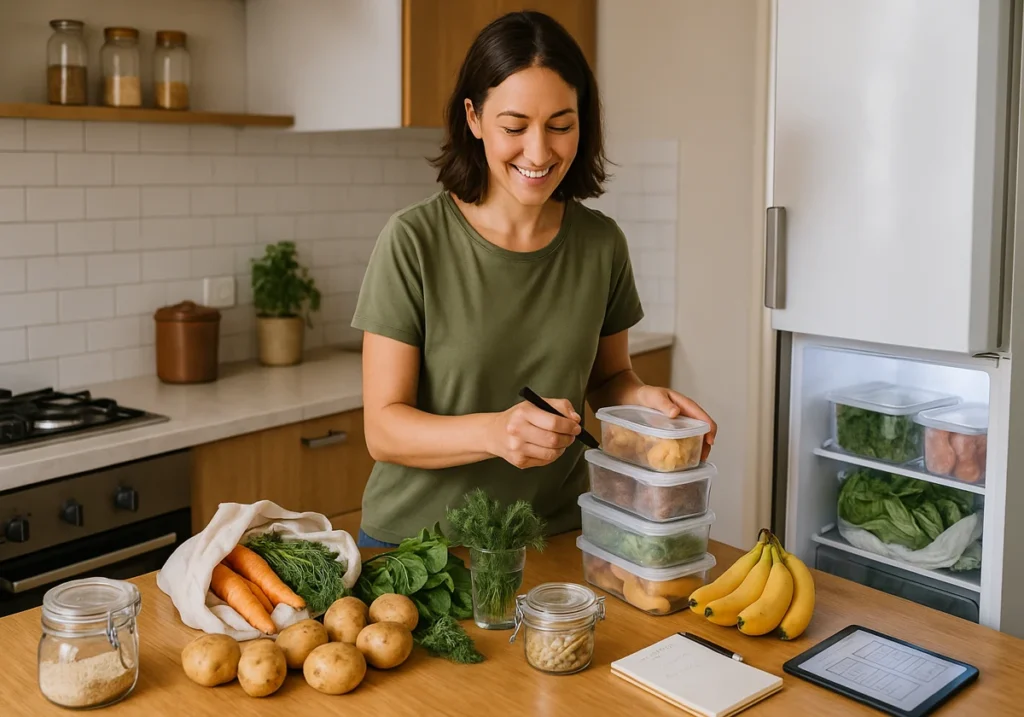Low-carbon cooking meals don’t mean you have to eat boring salads forever. Your favourite comfort foods can stay on the menu with a few simple changes. It will keep both you and the environment healthy.
Here’s a shocking fact: food production accounts for around one-quarter (26%) of global carbon emissions. The relief: low-carbon cooking directly addresses this problem. If you want to help reduce this emission, your kitchen’s cooking choices will play a bigger role.
This guide will help you discover practical alternatives, seasonal food picks, and a full week of tasty meals to make your kitchen low-carbon friendly. We know nobody wants to sacrifice flavour for sustainable food choices. And after reading this, you also don’t have to.
Why Low-Carbon Cooking Helps the Planet
The food system creates emissions at every stage of food production (from farm to table). Farms use energy and natural resources to grow crops and raise animals for meat and dairy products.
The thing here is that meat and dairy production generate the highest carbon footprint in our diet. Beef farming alone creates more emissions than growing most vegetables and fruits combined.
Apart from farming, your cooking method also affects energy use at home.
If you are boiling water for pasta, running your oven for hours, or keeping your fridge overpacked, all these methods add to your carbon footprint. But the relief is that small changes in your cooking style can reduce it with less effort.
Easy Food Swaps That Cut Your Carbon Footprint
Your sustainable food choices reduce your carbon footprint. (and, you don’t have to give up the meals you love.) We suggest that you stop thinking about complicated swaps from today. Here are three simple swaps you can start using:
| Instead Of This | Try This | Why It Works |
| Beef | Chicken, fish, lentils, chickpeas, or beans | Lower emissions from farming and less energy for transport |
| Pre-cut vegetables | Whole vegetables from farmers’ markets | Saves energy from processing and reduces packaging waste |
| Cheese-heavy meals | Cheese as a flavour boost only | Cuts dairy emissions while keeping the taste you love |
Pro tip from our kitchen: Mushrooms add meaty flavour to dishes without the emissions. We’ve tested portobello mushrooms in burgers and they genuinely satisfy your savoury craving.
Seasonal Foods Cut Your Carbon Footprint

Seasonal food grows naturally. It doesn’t need heated greenhouses or artificial lighting systems. Instead, growing tomatoes in winter requires a large amount of energy. You also need to spend extra energy to maintain the right temperature.
Summer tomatoes taste better anyway. And it costs you less money at the market. When you eat such seasonal foods, you support local farmers and reduce transportation emissions from your diet.
Winter brings pumpkins, sweet potatoes, and hearty root vegetables that are perfect for roasting. Spring and summer deliver zucchini, capsicums, and stone fruits bursting with flavour and vitamin C.
Air transport-based foods keep serious food miles away before reaching your plate. For instance, Berries from developing countries might look fresh, but their environmental impact tells a different story.
That’s why always check the labels or ask farmers where the produce comes from before buying. Why should you do it? Well, locally produced foods reduce air pollution caused by transportation. And it supports sustainable farming in your community.
What does it mean in particular, though? When you eat seasonally, you cut the carbon equivalent of driving hundreds of kilometres each year. You save money while helping reduce pollution.
Stop Food Waste (And Your Money Too)
According to the Australian Government, Australian households waste around 312 kilograms of food per person on a yearly basis. You’re tossing this food in the bin along with the money, energy, and resources farmers used to produce it.
Food waste creates methane when it decomposes in a junkyard. This polluting gas harms our natural environment more than regular carbon dioxide does for the future.
Now, let us teach you a few basic things you can follow to save your money, food, and environment:
- Store your vegetables properly to extend their life. It saves your own food from the bin. For example, leafy greens stay crisp in the fridge. So, use a crisper drawer with a damp cloth and wrap it around them.
- Carrots and potatoes are root vegetables that prefer cool, dark spots. So, put them outside the fridge.
- Your herbs last longer in a glass of water. That’s why sit them on the counter instead of packing.
- Freeze your extras before they spoil and rot. For instance, overripe bananas make excellent smoothies or banana bread. You can use them later for cooking.
- For a quick future meal, freeze your leftover cooked rice, pasta, and sauces. Even that half tin of tomatoes deserves a spot in the fridge or freezer for next use.
And that’s where things get interesting. Saving extra veggie pieces in the freezer until you have enough for stock is genuinely easy and fun to do at home.

Your 7-Day Low-Carbon Meal Plan
Now that you know, swapping your food is not that hard. Let us plan a week of low-carbon cooking that uses seasonal food and plant-based recipes. This food plan ensures your daily balance of nutrition and flavour while reducing your carbon footprint from your eating habits.
You’ll recognise most dishes because they’re your familiar, regular foods. We just adapted it for sustainable food practices. No special ingredients or complicated cooking techniques are required for these recipes.
Sustainable Food List for the Week
- Vegetables: Sweet potato, pumpkin, zucchini, capsicum, broccoli, carrots, leafy greens, tomatoes, mushrooms, onions, garlic.
- Proteins: Chickpeas (2 tins), lentils (1 tin), eggs, firm tofu, fish or chicken (optional).
- Pantry: Rice, pasta, oats, canned tomatoes, vegetable stock, olive oil, basic herbs and spices.
- Fruits: Bananas, apples, seasonal berries.
- Dairy or Alternatives: Greek yoghurt or plant-based version, milk of your choice.
Now, let’s check out the complete weekly plan below. Every meal balances flavour and nutrition while cutting your kitchen’s emissions.
Day 1: Monday
Breakfast: Porridge with sliced banana and honey.
Lunch: Chickpea and vegetable soup with bread.
Dinner: Roasted pumpkin and sweet potato with herb tofu.
Day 2: Tuesday
Breakfast: Scrambled eggs with mushrooms on toast.
Lunch: Leftover roasted vegetables wrapped in a tortilla.
Dinner: Lentil bolognese with brown pasta.
Day 3: Wednesday
Breakfast: Greek yoghurt with seasonal fruit and oats.
Lunch: Vegetable fried rice using leftover rice.
Dinner: Chickpea curry with steamed broccoli and rice.
Day 4: Thursday
Breakfast: Banana smoothie with oats and milk.
Lunch: Leftover curry with fresh bread.
Dinner: Stir-fried vegetables with rice noodles and peanuts.
Day 5: Friday
Breakfast: Tomato and mushroom omelette.
Lunch: Vegetable soup made from saved scraps.
Dinner: Baked fish with roasted root vegetables.
Day 6: Saturday
Breakfast: Weekend pancakes using plant milk.
Lunch: Big garden salad with chickpeas.
Dinner: Homemade pizza with seasonal vegetable toppings.
Day 7: Sunday
Breakfast: Avocado toast with cherry tomatoes.
Lunch: Vegetable pasta with tomato sauce.
Dinner: Bean stew with fresh bread.
You might be wondering whether this plan provides enough protein and nutrients. Right? It absolutely does.
Legumes pack protein, iron, and other nutrients your body needs for energy. Eggs deliver vitamin B12 and healthy fats. The variety of vegetables and fruits ensures you’re getting plenty of vitamins throughout the week.
The goal is to eat more plants and seasonal food regularly. Trust us! You’re not following any hard rules that don’t make sense for your life or cooking style.
Drawing from our experience: Cooking the same base ingredients in different ways keeps meals interesting during the week. Your Monday’s roasted vegetables become Tuesday’s wrap filling without doing extra work, shopping, or food waste.

Small Changes, Real Impact
You can start low-carbon cooking with one meal at a time. You don’t need to change your entire diet overnight or give up foods you love to eat. Just pick a few swaps from this guide and try our 7-day meal plan when you’re ready.
Every sustainable meal you cook creates real benefits for the natural environment and supports a healthier food system. Visit Eco4theWorld for more ideas, recipes, and ways to reduce your carbon footprint through simple everyday actions.
